
(From old proverb)
I love to stroll under the shade of majestic Valley oak trees in the oak woodland riparian habitat along the Stanislaus River at Caswell State Park in Ripon. I visualize Lakisamni Yokut women (the indigenous people who lived in Stanislaus County area for millennia) as they gathered acorns.
Vital Roles
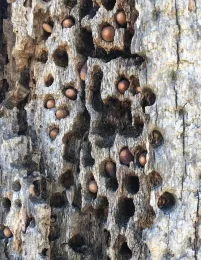
Early humans built their homes, created tools, built shelters and ships from oak wood. Oak galls were used to make dyes, writing ink, and tan leather. Today we use its strong wood to construct furniture, flooring, cabinets, and wine barrels. If you like truffles, thank oak trees, since truffles have a close relation with the roots of oak trees. Truffles are almost impossible to grow. Instead, truffle farmers plant oak trees, hoping to create favorable conditions conducive to the growth of truffles.
California Oaks
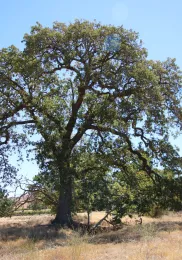
- Valley oak (Quercus lobata) – One of California's iconic species, it is the largest oak tree found here, living up to 300 years. The Valley oak grows where there is a water table within reach of the roots, often near creeks and rivers. They grow quickly, reaching 20 feet in 5 years and up to 60 feet in 20 years. A deciduous tree, it's distinguished by deeply lobed shiny green leaves and long, narrow acorns.
- Interior live oak (Quercus wislizenii) – An evergreen tree, growing up to 25-80 feet tall, it is found in hilly or mountainous areas, near creeks and streams, living up to 200 years. It can produce two types of leaves at the same time, one with a serrated edge and the other with a smooth edge, and produces small, thin acorns.
- Blue oak (Quercus douglasii) – A deciduous tree found in the hot, dry foothills, it grows to be 20-60 feet tall with blue-green leaves which vary in size and shape. With a lifespan of 200-500 years, their acorns are fat and stubby.
Oaks tolerate fire due to their thick, furrowed bark and tough leathery leaves. During wildfires, the larger oaks in areas cleared of fuel may scorch, but rarely burn completely. Damaged trees will resprout from the root crown.
Acorns
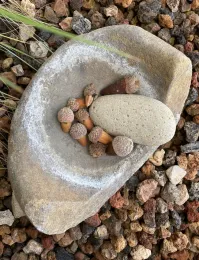
An oak tree can produce millions of acorns during its lifetime, but only one in 10,000 acorns grows up to be an oak tree. Acorns are highly nutritious, carbohydrate-rich, and were a diet staple of the Californian indigenous people. Mammals and birds who eat acorns include the Acorn woodpecker, Yellow-billed magpie, California ground squirrel, and Mule deer. However, acorns are toxic to dogs and horses.
The indigenous people called the California scrub jay the “gardener bird” because of its propensity for caching thousands of acorns and not eating all of them, which helped replenish and expand oak forests.
Oak Galls
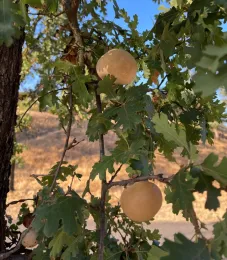
A favorite oak gall of mine is “jumping galls,” the size of poppy seeds, round with a dot in the center. Some years large numbers of them drop and litter the ground and sidewalks. The galls “jump” each time the larva moves inside. You can see this in action in this YouTube video: https://www.youtube.com/watch?v=0VI7USm4J5I
Oak Challenges
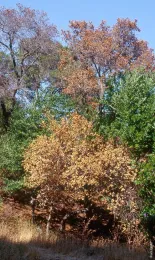
Today, oak trees face many challenges. Disease, drought, and fire can all destroy oak seedlings. Young oaks are stepped on by grazing animals or run over by machinery. Full grown oaks are often damaged or killed when new homes, roads, stores, or businesses are built. Sudden Oak Death is a disease caused by the pathogen Phytophthora ramorum,discovered in Mill Valley in 1995. Causing a rapid color change from green leaves to brown in infected oaks, it has killed thousands of live oak, black oak, tanoak, and Shreve oak in 14 California counties. Climate change is also putting pressure on oak trees.
To maintain a forest or woodland, each oak tree needs to produce just one replacement tree in its lifetime. You can help regenerate California oak habitat by caring for an acorn seedling and protecting it from harm while it grows into a mighty oak.
All photos by Denise Godbout-Avant unless otherwise noted.

